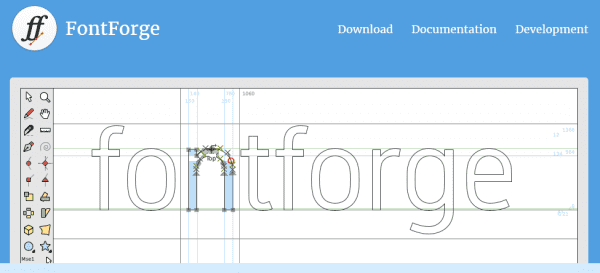

- USING FONTFORGE MAC OS X
- USING FONTFORGE FULL
- USING FONTFORGE SOFTWARE
- USING FONTFORGE CODE
- USING FONTFORGE FREE
(You'll have to re-load your original font file to undo this step)
USING FONTFORGE FULL
If you scroll through the full list of glyphs, you'll see there's extra special characters – A whole bunch of them! If you don't need them in your project, just select "space" (the glyph just before "!") plus the basic set of upper/lower and alphanumeric characters. In cases where you need to save on every byte, you can optimize the file size of your fonts by selecting only the characters you want to use. bdf, it's roughly around 900K – That can be a bit larger than needed, especially if you plan to store a lot of image and sound assets. you take a look at the file size of the.
USING FONTFORGE MAC OS X
In 2011, FontForge was packaged for easier installation on Mac OS X by Dr. FontForge's development became more active, and Khaled Hosny and Barry Schwartz were notable contributors, but in late 2012 they and Crossland disagreed about the direction of the project so they forked FontForge as SortsMill Tools. Crossland began offering introductory type design workshops through the TeX Users Group (TUG) to raise funds to hire contract developers to maintain and develop the program. In mid-2011, Dave Crossland began contributing to the project and the project moved from SourceForge to GitHub. Williams actively developed, maintained and supported the program and related utilities for around 12 years. The FontForge project was founded by George Williams as a retirement project, and initially published from 2001 to March 2004 as PfaEdit). FontForge also imports and exports fonts to and from the Scalable Vector Graphics (SVG) format and the Unified Font Object (UFO) format. Supported font formats include: TrueType (TTF), TrueType Collection (TTC), OpenType (OTF), PostScript Type 1, TeX Bitmap Fonts, X11 OTB bitmap (only sfnt), Glyph Bitmap Distribution Format (BDF), FON (Windows), FNT (Windows), and Web Open Font Format (WOFF).

USING FONTFORGE SOFTWARE
The software supports many other font formats and converts fonts from one format to another. FontForge also supports the interoperable UFO source format, which is based on XML. sfd file name extension) is text-based and facilitates collaboration between designers, as difference files can be easily created. Its native Spline Font Database format (.
USING FONTFORGE CODE
The FontForge source code includes a number of utility programs, including 'showttf' which shows the contents of binary font files, and a WOFF converter and deconverter.įontForge supports a wide variety of font formats. Parts of FontForge code are used by the LuaTeX typesetting engine for reading and parsing OpenType fonts. Since the Novemrelease, FontForge uses libcairo and libpango software libraries for graphics and text rendering providing anti-aliased graphics and complex text layout support.įontForge can use Potrace or AutoTrace to auto trace bitmap images and import them into a font.
USING FONTFORGE FREE
At least one free OpenType mathematical font has been developed in FontForge.įontForge uses FreeType for rendering fonts on screen. It also supports the unofficial Microsoft mathematical typesetting extensions ( MATH table) introduced for Cambria Math and supported by Office 2007, XeTeX and LuaTeX. įontForge supports Adobe's OpenType feature file specification (with its own extensions to the syntax). FontForge can run scripts from its GUI, from the command line, and also offers its features as a Python module so it can be integrated into any Python program. To facilitate automated format conversion and other repetitive tasks, FontForge implements two scripting languages: its own language and Python.


 0 kommentar(er)
0 kommentar(er)
